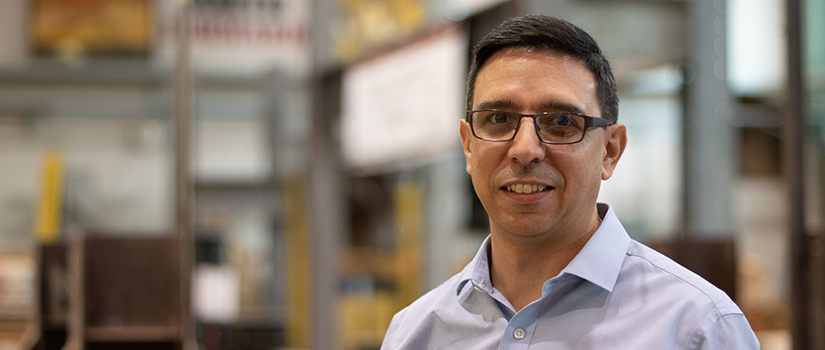According to the U.S. Census Bureau, the nation’s 65-and-older population grew by 34% in the last decade. In addition, connecting doctors and patients online via telehealth to provide care has become increasingly popular.
The combination of a rapidly aging population and increasing virtual health care technology is leading Professor Juan Caicedo of the Civil and Environmental Engineering Department to help develop technology that determines if differences in a person’s walk, or gait, estimated from structural vibrations can indicate changes in health.
Caicedo is currently in the third year of a four-year, $1.1 million grant from the National Institute on Aging. His research ties together engineering, exercise science and healthcare applications. Caicedo is working with Professor Stacy Fritz, an expert in gait parameters from the Arnold School of Public Health and Dr. Victor Hirth, chief of geriatrics at Geriatric Health & Wellness, Ltd.
Caicedo is collecting the necessary data to enable a smart system that uses floor vibrations to estimate gait parameters, which refers to measurement of human motion, and determine if health changes are prevalent. “It’s a new research arena because of the lack of technology to estimate gait parameters at home,” Caicedo says. “We want future researchers to see how changes in health are related to changes in gait parameters and have them determine its meaning.”
The multi-phased process is an extension of Caicedo’s previous research on how floor vibrations can detect falls by using seismic sensors placed on floors. The first development of his current research ensured the signal is from a person’s walk. His research team is currently estimating gait parameters when an individual walks past sensors. Once those parameters are estimated, the data will be sent to Fritz and Hirth to interpret the results.
“We have shown that it works theoretically, but putting reality into the mix and applying it to an actual system is challenging,” Caicedo says. “There were similar difficulties with our previous research, but we eventually fine-tuned everything, which is where we’re at right now. We're putting the package together to be able to have a set of sensors and install them in homes, which we hope to start doing this fall.”
Caicedo’s team used sensors from existing stock instead of creating new devices. Using sensors in the floor is an advantage over other monitoring devices, which may need a battery recharge or change. People may also forget to wear their devices or take them off, especially at night. The sensors provide continuous monitoring without any interaction with the system. “The main point of this technology is to be the least intrusive as possible so the person will not know the technology is there. You can put them under the floor or in a crawl space in an existing or new home,” Caicedo says.
Fritz’s research has shown a correlation between walking speeds and health status at doctor’s offices. She intends to use Caicedo’s data to interpret the results and validate the system. Fritz will also examine step length (how far feet are apart as someone is walking) and other parameters to determine if sensors can accurately assess gait parameters at home.
“We want to use gait parameters, especially walking speeds, as a window into someone's health. Right now, we are trying to figure out if we can do this with vibrations,” Fritz says. “Juan will send me data that’s reasonable change [of gait parameters]. For example, if the vibrations are picking up a change of .2 meters per second, we know that it needs to be more refined and closer to .1 meters per second or lower. We want to hone in on a number that’s helpful for a clinician.”
Caicedo’s initial research only focused on protecting the elderly, but Hirth suggested there are also preventative applications. The technology can detect severe health changes before they happen, allowing a doctor to provide early intervention.
“Some of the components have the ability to monitor energy delivery into the floor system over time, which can recognize someone's routine,” Hirth says. “For example, anyone who has had flu knows there is aching and slowing down before the full-blown fever and chills. Sensors could determine those types of changes based on how active someone is in their home.”
Caicedo also believes this technology could lead to other healthcare applications and intends to test it with post-surgical recovery. Instead of identifying connections between a decrease in gait parameters and negative health changes, research will also be conducted to find correlations between faster gait parameters and successful recovery.
“Sensors could be temporarily installed in homes to track the progress of recovery for people of all ages,” Caicedo says. “I envision a technology where the health status can be channeled to a doctor, who can determine if the patient needs to be hospitalized again.”
While Caicedo’s research can answer initial questions on how floor vibrations determine health changes, he admits there are plenty of unknowns. But he hopes his research can aid future researchers provide meaning to his data.
“What happens if a person’s gait parameters change in the morning but not the afternoon? Or if a person is walking less, but the gait parameters are not changing,” Caicedo says. “There are still questions that need to be discovered, and we hope this technology aids future research.”
